Docmercy
On this page, you find all documents, package deals, and flashcards offered by seller Docmercy.
- 668
- 0
- 0
Community
- Followers
- Following
668 items
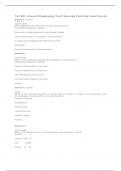
NSG 5003: Advanced Pathophysiology Week 5 Knowledge Check Quiz:
NSG 5003: Advanced Pathophysiology Week 5 Knowledge Check Quiz: South University Question 1 (1 point) 5 out of 5 correct Saved Which statement best describes the major characteristic of bronchiolitis? Question 1 options: Destruction of lung parenchyma and collapse of distal airways Obstruction by eosinophilic mucous plugs in the upper airway Widespread inflammation of the bronchioles Extensive constriction of the bronchioles Question 2 (1 point) Saved Which of the following physiologic...
- Exam (elaborations)
- • 3 pages •
NSG 5003: Advanced Pathophysiology Week 5 Knowledge Check Quiz: South University Question 1 (1 point) 5 out of 5 correct Saved Which statement best describes the major characteristic of bronchiolitis? Question 1 options: Destruction of lung parenchyma and collapse of distal airways Obstruction by eosinophilic mucous plugs in the upper airway Widespread inflammation of the bronchioles Extensive constriction of the bronchioles Question 2 (1 point) Saved Which of the following physiologic...
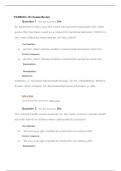
NURSING 111 Exams Review
NURSING 111 Exams Review Question 1 See full question 24s An adolescent client says the client has become bored with the video game that has been used as a reward for positive behavior. Which is the most effective intervention for this client? You Selected: ● Let the client choose another reward that would be more fun. Correct response: ● Let the client choose another reward that would be more fun. Explanation: Remediation: Reference: Videbeck, S. Psychiatric-Mental Health Nurs...
- Exam (elaborations)
- • 195 pages •
NURSING 111 Exams Review Question 1 See full question 24s An adolescent client says the client has become bored with the video game that has been used as a reward for positive behavior. Which is the most effective intervention for this client? You Selected: ● Let the client choose another reward that would be more fun. Correct response: ● Let the client choose another reward that would be more fun. Explanation: Remediation: Reference: Videbeck, S. Psychiatric-Mental Health Nurs...
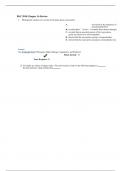
BSC 2010 Chapter 16 Review
BSC 2010 Chapter 16 Review 1. Phylogenetic analysis of a section of the plant genus Leptosiphon A. was based on the sequences of mitochondrial DNA. B. revealed that L. “bicolor” is actually three distinct lineages. C. revealed that an ancestral species of the Leptosiphon group was likely to be self-compatible. D. showed that the Leptosiphon group is synapomorphic. E. showed that the Leptosiphon group has a homoplastic trait. Correct See Concept 16.3: Phylogeny Makes Biology C...
- Exam (elaborations)
- • 13 pages •
BSC 2010 Chapter 16 Review 1. Phylogenetic analysis of a section of the plant genus Leptosiphon A. was based on the sequences of mitochondrial DNA. B. revealed that L. “bicolor” is actually three distinct lineages. C. revealed that an ancestral species of the Leptosiphon group was likely to be self-compatible. D. showed that the Leptosiphon group is synapomorphic. E. showed that the Leptosiphon group has a homoplastic trait. Correct See Concept 16.3: Phylogeny Makes Biology C...
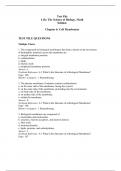
Test File Life: The Science of Biology, Ninth Edition Chapter 6: Cell Membranes
Test File Life: The Science of Biology, Ninth Edition Chapter 6: Cell Membranes TEST FILE QUESTIONS Multiple Choice 1. The compounds in biological membranes that form a barrier to the movement of hydrophilic materials across the membrane are a. integral membrane proteins. b. carbohydrates. c. lipids. d. nucleic acids. e. peripheral membrane proteins. Answer: c Textbook Reference: 6.1 What Is the Structure of a Biological Membrane? Page: 106 Bloom’s Category: 1. Remember...
- Exam (elaborations)
- • 34 pages •
Test File Life: The Science of Biology, Ninth Edition Chapter 6: Cell Membranes TEST FILE QUESTIONS Multiple Choice 1. The compounds in biological membranes that form a barrier to the movement of hydrophilic materials across the membrane are a. integral membrane proteins. b. carbohydrates. c. lipids. d. nucleic acids. e. peripheral membrane proteins. Answer: c Textbook Reference: 6.1 What Is the Structure of a Biological Membrane? Page: 106 Bloom’s Category: 1. Remember...
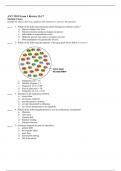
ANT 2301 Exam 1 Review 15-17
ANT 2301 Exam 1 Review 15-17 Multiple Choice Identify the choice that best completes the statement or answers the question. 1. Which of the following statements about biological evolution is false? a. Species change over time. b. Natural selection produces changes in species. c. Individuals in a population evolve. d. Different species may share a common ancestor. e. Most populations are genetically diverse. 2. Which of the following descriptions of the gene pool shown below is c...
- Exam (elaborations)
- • 18 pages •
ANT 2301 Exam 1 Review 15-17 Multiple Choice Identify the choice that best completes the statement or answers the question. 1. Which of the following statements about biological evolution is false? a. Species change over time. b. Natural selection produces changes in species. c. Individuals in a population evolve. d. Different species may share a common ancestor. e. Most populations are genetically diverse. 2. Which of the following descriptions of the gene pool shown below is c...
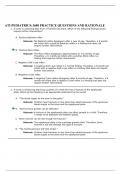
ATI PEDIATRICS:1600 PRACTICE QUESTIONS AND RATIONALE
ATI PEDIATRICS:1600 PRACTICE QUESTIONS AND RATIONALE 1. A nurse is collecting data from a 9-month-old infant. Which of the following findings would require further intervention? A. Positive Babinski reflex Rationale: The Babinski reflex disappears after 1 year of age. Therefore, a 9-month-old infant with a positive Babinski reflex is a finding that does not require further intervention. B. Positive Moro reflex Rationale: The Moro reflex disappears approximately at 3-4 months of age. The...
- Exam (elaborations)
- • 117 pages •
ATI PEDIATRICS:1600 PRACTICE QUESTIONS AND RATIONALE 1. A nurse is collecting data from a 9-month-old infant. Which of the following findings would require further intervention? A. Positive Babinski reflex Rationale: The Babinski reflex disappears after 1 year of age. Therefore, a 9-month-old infant with a positive Babinski reflex is a finding that does not require further intervention. B. Positive Moro reflex Rationale: The Moro reflex disappears approximately at 3-4 months of age. The...
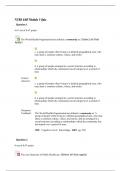
NURS 4465 Module 1 Quiz
NURS 4465 Module 1 Quiz • Question 1 6.67 out of 6.67 points The World Health Organization has defined a community as: (Select all that apply) c. a group of people often living in a defined geographical area, who may share a common culture, values, and norms d. a group of people arranged in a social structure according to relationships which the community has developed over a period of time Correct Answers: c. a group of people often living in a defined geographical are...
- Exam (elaborations)
- • 10 pages •
NURS 4465 Module 1 Quiz • Question 1 6.67 out of 6.67 points The World Health Organization has defined a community as: (Select all that apply) c. a group of people often living in a defined geographical area, who may share a common culture, values, and norms d. a group of people arranged in a social structure according to relationships which the community has developed over a period of time Correct Answers: c. a group of people often living in a defined geographical are...
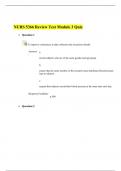
NURS 5366 Review Test Module 3 Quiz
NURS 5366 Review Test Module 3 Quiz • Question 1 To improve consistency in data collection the researcher should: Answers : a. recruit subjects who are of the same gender and age group. b. ensure that the same member of the research team distributes blood pressure logs to subjects. c. request that subjects record their blood pressure at the same time each day. Response Feedback: p.508 • Question 2 A researcher evaluates scores of a paper an...
- Exam (elaborations)
- • 16 pages •
NURS 5366 Review Test Module 3 Quiz • Question 1 To improve consistency in data collection the researcher should: Answers : a. recruit subjects who are of the same gender and age group. b. ensure that the same member of the research team distributes blood pressure logs to subjects. c. request that subjects record their blood pressure at the same time each day. Response Feedback: p.508 • Question 2 A researcher evaluates scores of a paper an...
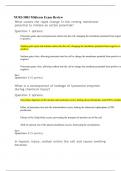
NURS 5003 Midterm Exam Review
NURS 5003 Midterm Exam Review What causes the rapid change in the resting membrane potential to initiate an action potential? Question 1 options: Potassium gates open and potassium rushes into the cell, changing the membrane potential from negative to positive Sodium gates open and sodium rushes into the cell, changing the membrane potential from negative to positive. Sodium gates close, allowing potassium into the cell to change the membrane potential from positive to negative. Pota...
- Exam (elaborations)
- • 18 pages •
NURS 5003 Midterm Exam Review What causes the rapid change in the resting membrane potential to initiate an action potential? Question 1 options: Potassium gates open and potassium rushes into the cell, changing the membrane potential from negative to positive Sodium gates open and sodium rushes into the cell, changing the membrane potential from negative to positive. Sodium gates close, allowing potassium into the cell to change the membrane potential from positive to negative. Pota...
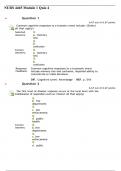
NURS 4465 Module 1 Quiz 4
NURS 4465 Module 1 Quiz 4 • Question 1 6.67 out of 6.67 points Common cognitive responses to a tramatic event include: (Select all that apply) Selected Answers: a. memory loss b. confusion Correct Answers: a. memory loss Response Feedback: b. confusion Common cognitive responses to a traumatic event include memory loss and confusion, imparied ability to concentrate or make decisions. DIF. Cognitive Level: Knowledge REF. p. 518 • Question 2 ...
- Exam (elaborations)
- • 8 pages •
NURS 4465 Module 1 Quiz 4 • Question 1 6.67 out of 6.67 points Common cognitive responses to a tramatic event include: (Select all that apply) Selected Answers: a. memory loss b. confusion Correct Answers: a. memory loss Response Feedback: b. confusion Common cognitive responses to a traumatic event include memory loss and confusion, imparied ability to concentrate or make decisions. DIF. Cognitive Level: Knowledge REF. p. 518 • Question 2 ...
